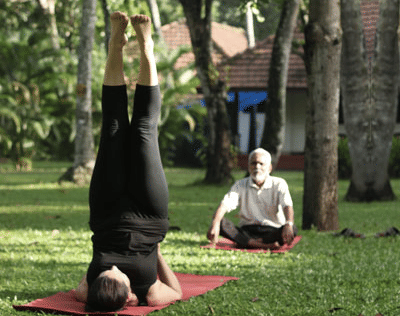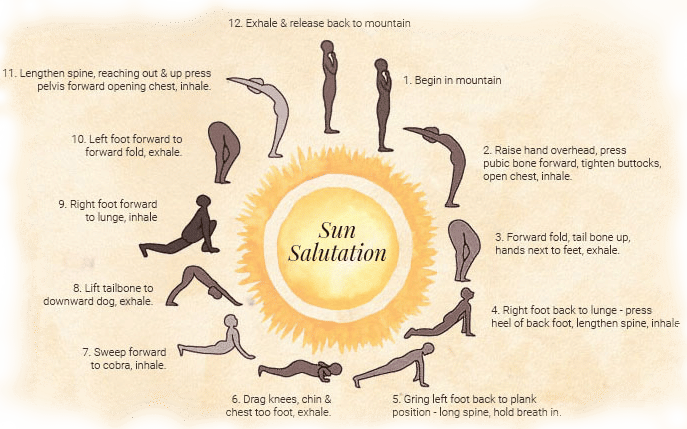Home > Yoga
_dad88e48)
Yoga
युज्यते अनेन इति योग: ॥
Yoga, propounded by Patanjali, is the ancient Indian knowledge where one’s own consciousness (Jivatma) reunites with universal consciousness (Paramatma). In Sanskrit, Yuj means joining or to unite.
योग: चित्त-वृत्ति निरोध: ॥
Yoga Sutras 1.2
Yoga is also defined as the one that inhibits the transformation of the mind and keeps the mind free from discursive thoughts.
The practice of Yoga focuses the mind and body in eliciting the relaxation response to relieve oneself from physical and mental stress and achieve equilibrium of the body, mind, and soul. Union with this unchanging reality liberates the spirit from all sense of separation, freeing it from the illusions of time, space, and causation.
Yoga is therefore regarded as a divine science of life, revealed to enlightened sages in meditation. First textual mention in the Vedas was corroborated by the oldest archaeological evidence of seals from the Indus Valley, dating back to around 3,000 B.C. The Upanishads that followed the Vedas provide the main foundation of Vedanta philosophy (which espouses the idea of an absolute consciousness called Brahma) and Yoga teachings. Around the 6th century B.C. appeared the massive epic The Mahabharata written by sage Vyasa and containing The Bhagavad Gita. The Gita contains Yoga terms and concepts to enable the reader to face life similarly.
The backbone of Raja Yoga is furnished by Patanjali's Yoga Sutra, thought to have been written in the 3rd century B.C. The classical text on Hatha Yoga, the Hatha Yoga Pradipika, which describes the various asanas and breathing exercises which form the basis of the practice of modern Yoga, was compiled much later by a yogi named Svatmarama.
In the modern perspective, Yoga is one of the most effective and wholesome forms of experience to control the waves of thought by converting mental and physical energy into spiritual energy. Yoga eases away pent-up tension, rejuvenates the body, and soul, enhances concentration, cures diseases, and keeps a hold on the ageing process. The physiological and psychological benefits derived from Yoga make it an inevitable element in spiritual and secular healing.
Benefits of Yoga

Preventive Value
- Yoga helps to bring natural order and balance to the neuro-hormones and metabolism in the body.
- At the same time, these exercises improve endocrine metabolism, thus providing you with a preventive shield.
Curative Value
- Yogic postures activate the energies that have accumulated and stagnated in the energy pockets of the body. Since left inert, these energies create various ailments.
- Yogic exercises cleanse your body, mind, and consciousness by venting toxins from the body.
Pranayam
प्राणापानगती रुद्ध्वा प्राणायामपरायणाः ।
अपरे नियताहाराः प्राणान्प्राणेषु जुह्वति ॥२९॥
Bhagavad Gita 4.29
Pranayama, otherwise known as Breathing Exercise, has its origin from 2 Sanskrit words, Prana, meaning breath and Ayama, meaning exercise. This system of Yoga was earlier mentioned in the Bhagavad Gita and was later seen to be practised by Hatha Yoga followers. A comfortable sitting posture is recommended for its practice, though Padmasana (Lotus Position) is said to be the ideal posture. It mainly benefits in rewarding good sensual perception and spiritual awakening as it involves controlling the movements of Prana Vayu (air located in the head) and Apana Vayu (air located in the lower abdomen). The process of slow air inhalation is called Puraka. Air that is inhaled is then withheld in the throat, known as Kumbhaka, and finally it is exhaled slowly, which is called Rechaka. This Pranayam practice is to be performed in the morning hours (before or after sunrise) on an empty stomach, which helps in enriching the blood with oxygen, thereby energising the whole body systems. It is said that this practice in turn helps the respiratory volumes and cleanses the body channels.
Surya Namaskar
जन्मान्तरसहस्रेषु दारिद्र्यं नोपजायते।।
One who practices Surya Namaskar is bound to live a healthy life without miseries. This practice of Yoga is done facing the early morning sunrise, which benefits the individual in many ways, both physiologically and mentally. The movements and breathing techniques adopted in the eleven postures of Surya Namaskar improve blood circulation, body metabolism, flexibility of spine, and other joints, and concentration.

Asanas
Yoga Sutras
Asana in Sanskrit defines a seat or sitting posture. Patanjali has termed Asana as one among the 8 components of Yoga, where one can hold a posture for an extended period of time by staying relaxed, steady, comfortable, and motionless. The posture that causes pain or restlessness is not a proper asana.
Newsletter Sign-up
Subscribe to our newsletter! Receive updates on the latest news and offers.